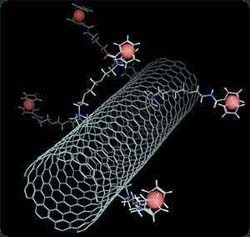Nanopollution refers to the waste matter or byproducts of nanoscopic device or material manufacture. Nanoscopic device or material manufacturing processes leave behind nanoparticles (smaller than a billionth of a meter) which can infiltrate the cells of humans, animals and all living organisms that may be unprepared for the influx of artificial particles. A 1941 study from Johns Hopkins Hospital discovered that nanoscopic particles, when inhaled, could make their way into the brain via the olfactory tract. This raises some concerns about the possible health risks connected to the recent developments in nanoscience and nanotechnology.
Nanopollution Studies
A 2007 study revealed that mineral nanoparticles from agricultural runoff and sewage were already present in the some rivers of Britain. This opens up questions about nanopollution where nanoscopic particles could get past the body's defenses yet bring with them several kinds of antigens.
Another study, conducted by Eva Oberdorster, examined the results of exposing captive large-mouth bass to varying concentrations of Carbon-60, a nanoscopic molecule. Two days later, the toxicologist from Southern Methodist University found indicators of an immune response in the livers of the fish population in the setup. This suggests the possibility that the molecules were able to bypass the fishes' immune systems, even the one for the nervous system. This study raises concerns that nanoparticles could be small enough to bypass certain immune systems and do some damage to the body before they're even detected. The same result was also found in a similar study on mammals.
Nanopollution for Humans
Carbon-60 is a fullerene, a group of nanoparticles precisely designed to have increased heat resistance and other properties that make it useful for industrial purposes. Experts say that because of their chemical properties, fullerenes will most probably find themselves in landfills or dumpsters as non-biodegradable waste, fully exposed to the open air. Moreover, fullerene today is used in common objects, in things from lubricants to sports equipment.
Experts point out, though, that many fullerene chemicals are not harmful. Most fullerenes were designed to have a very stable coating on the surface, bonding the carbon to the surface coating and rendering the substance non-toxic.
Should nanopollution carry a threat, there is a need for studies that will determine what damage they could possibly have on the human body. As nearly all nanoparticles are either manmade, pollutant or both, scientists see it highly unlikely that the human body would have a prepared defense against a new, smaller intruder.
The experts also point out that the human beings, particularly those who live in urban areas, are most probably already heavily exposed to nanopollution. The exhaust from cars, the manganese oxide from construction sites and many other byproducts and substances add up to tons and tons of nanoscopic pollution that city-dwellers inhale everyday. These carry a higher level of danger because they are not engineered or designed by humans and therefore have no non-toxic covering to prevent them from harming people; the surface covering of nanoscopic materials is very important in determining their toxicity.




TECHgeek
AMAZING! But the causes and mitigation needs to be discussed in depth.